
Hofkirche, Innsbruck
Encyclopedia
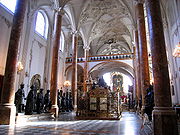
Innsbruck
- Main sights :- Buildings :*Golden Roof*Kaiserliche Hofburg *Hofkirche with the cenotaph of Maximilian I, Holy Roman Emperor*Altes Landhaus...
, Austria
Austria
Austria , officially the Republic of Austria , is a landlocked country of roughly 8.4 million people in Central Europe. It is bordered by the Czech Republic and Germany to the north, Slovakia and Hungary to the east, Slovenia and Italy to the south, and Switzerland and Liechtenstein to the...
, is a Gothic
Gothic architecture
Gothic architecture is a style of architecture that flourished during the high and late medieval period. It evolved from Romanesque architecture and was succeeded by Renaissance architecture....
church built 1553–1563 by Ferdinand I
Ferdinand I, Holy Roman Emperor
Ferdinand I was Holy Roman Emperor from 1558 and king of Bohemia and Hungary from 1526 until his death. Before his accession, he ruled the Austrian hereditary lands of the Habsburgs in the name of his elder brother, Charles V, Holy Roman Emperor.The key events during his reign were the contest...
as a memorial to his grandfather Maximilian I, Holy Roman Emperor
Maximilian I, Holy Roman Emperor
Maximilian I , the son of Frederick III, Holy Roman Emperor and Eleanor of Portugal, was King of the Romans from 1486 and Holy Roman Emperor from 1493 until his death, though he was never in fact crowned by the Pope, the journey to Rome always being too risky...
(1459–1519), whose cenotaph
Cenotaph
A cenotaph is an "empty tomb" or a monument erected in honour of a person or group of people whose remains are elsewhere. It can also be the initial tomb for a person who has since been interred elsewhere. The word derives from the Greek κενοτάφιον = kenotaphion...
within boasts a remarkable collection of German Renaissance
Renaissance
The Renaissance was a cultural movement that spanned roughly the 14th to the 17th century, beginning in Italy in the Late Middle Ages and later spreading to the rest of Europe. The term is also used more loosely to refer to the historical era, but since the changes of the Renaissance were not...
sculpture. It also contains the tomb of Andreas Hofer
Andreas Hofer
Andreas Hofer was a Tirolean innkeeper and patriot. He was the leader of a rebellion against Napoleon's forces....
, Tirol
German Tyrol
German Tyrol is a historical region in the Alps now divided between Austria and Italy. It includes largely ethnic German areas of historical County of Tyrol: the Austrian state of Tyrol and the province of South Tyrol but not the largely Italian-speaking province of Trentino .-History:German...
's national hero.
Although Maximilian's will had directed that he be buried in the castle chapel in Wiener Neustadt
Wiener Neustadt
-Main sights:* The Late-Romanesque Dom, consecrated in 1279 and cathedral from 1469 to 1785. The choir and transept, in Gothic style, are from the 14th century. In the late 15th century 12 statues of the Apostles were added in the apse, while the bust of Cardinal Melchior Klesl is attributed to...
, it proved impractical to construct there the large memorial whose plans he had supervised in detail, and Ferdinand I as executor planned construction of a new church and monastery in Innsbruck for a suitable memorial. In the end, however, Maximilian's simple tomb remained in Wiener Neustadt and the Hofkirche serves as a cenotaph.
Church
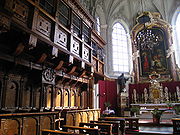
Trento
Trento is an Italian city located in the Adige River valley in Trentino-Alto Adige/Südtirol. It is the capital of Trentino...
, in the traditional German form of a hall church
Hall church
A hall church is a church with nave and side aisles of approximately equal height, often united under a single immense roof. The term was first coined in the mid-19th century by the pioneering German art historian Wilhelm Lübke....
that consists of three nave
Nave
In Romanesque and Gothic Christian abbey, cathedral basilica and church architecture, the nave is the central approach to the high altar, the main body of the church. "Nave" was probably suggested by the keel shape of its vaulting...
s with a setback three-sided choir, round and pointed arch windows, and a steep crippled hip roof. Its layered buttress
Buttress
A buttress is an architectural structure built against or projecting from a wall which serves to support or reinforce the wall...
es reflect compromise of contemporary Renaissance design with German late Gothic style. Stonemasons Hieronymus de Longhi and Anton de Bol carved the fine Renaissance portal. The interior contains galleries, high slender colonnettes of red marble with white stylized Corinthian capitals, and a lectern. The gallery's original ribs made from sandstone
Sandstone
Sandstone is a sedimentary rock composed mainly of sand-sized minerals or rock grains.Most sandstone is composed of quartz and/or feldspar because these are the most common minerals in the Earth's crust. Like sand, sandstone may be any colour, but the most common colours are tan, brown, yellow,...
from Mittenwald
Mittenwald
Mittenwald is a German municipality in the district of Garmisch-Partenkirchen, in Bavaria.-Geography:Mittenwald is located approx. 16 kilometers to the south-east of Garmisch-Partenkirchen...
have been preserved, but after the main vault was damaged by earthquake in the 17th century, it was rebuilt in the baroque
Baroque
The Baroque is a period and the style that used exaggerated motion and clear, easily interpreted detail to produce drama, tension, exuberance, and grandeur in sculpture, painting, literature, dance, and music...
style.
The high altar seen today was designed in 1755 by the Viennese court architect Nicolaus Pacassi, and decorated with a crucifixion
Crucifixion
Crucifixion is an ancient method of painful execution in which the condemned person is tied or nailed to a large wooden cross and left to hang until dead...
by the Viennese academic painter Johann Carl Auerbach, and bronze statues of saints Francisco and Theresa by Innsbruck court sculptor Balthasar Moll (1768). The Renaissance organ (1560) is by Jörg Ebert of Ravensburg
Ravensburg
Ravensburg is a town in Upper Swabia in Southern Germany, capital of the district of Ravensburg, Baden-Württemberg.Ravensburg was first mentioned in 1088. In the Middle Ages, it was an Imperial Free City and an important trading centre...
, and described locally as one of the five most famous organs in the world. Domenico Pozzo from Milan
Milan
Milan is the second-largest city in Italy and the capital city of the region of Lombardy and of the province of Milan. The city proper has a population of about 1.3 million, while its urban area, roughly coinciding with its administrative province and the bordering Province of Monza and Brianza ,...
painted the organ panels.
A side chapel, the Silver Chapel, was consecrated in 1578. It contains a silver altar to Mary incorporating three elephant tusks and three hundred kilos of ebony, and the tombs of Archduke Ferdinand II and his wife Philippine Welser (both by Alexander Colin).
Cenotaph
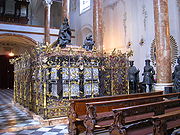
Mannerism
Mannerism is a period of European art that emerged from the later years of the Italian High Renaissance around 1520. It lasted until about 1580 in Italy, when a more Baroque style began to replace it, but Northern Mannerism continued into the early 17th century throughout much of Europe...
. Its construction took more than 80 years; the sarcophagus itself was completed in 1572, and in 1584 its final embellishments were added (the kneeling emperor, four virtues, and iron grille).
Trento mason Hieronymus Longi directed construction of the tomb proper. It consists of a base of the Hagau marble, a bronze relief frieze of trophies (vases, suit of armor, weapons, shields, musical instruments etc.), and above that two rows of white marble reliefs. The 24 reliefs were created by the artist Alexander Colin, based on woodcut
Woodcut
Woodcut—occasionally known as xylography—is a relief printing artistic technique in printmaking in which an image is carved into the surface of a block of wood, with the printing parts remaining level with the surface while the non-printing parts are removed, typically with gouges...
s from the "The Triumphal Arch ("Ehrenpforte") by Albrecht Dürer
Albrecht Dürer
Albrecht Dürer was a German painter, printmaker, engraver, mathematician, and theorist from Nuremberg. His prints established his reputation across Europe when he was still in his twenties, and he has been conventionally regarded as the greatest artist of the Northern Renaissance ever since...
, with four stone bas-reliefs each on the tomb's ends, and eight on its longer sides. They depict events from Maximilian's life as follows:
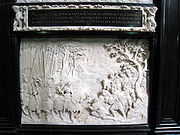
- 1 Maximilian's Wedding with Maria of Burgundy 1477
- 2 The First Battle of Guinegate 1478
- 3 The Recapture of Arras 1492
- 4 The Crowning of Maximilian as King of the RomansKing of the RomansKing of the Romans was the title used by the ruler of the Holy Roman Empire following his election to the office by the princes of the Kingdom of Germany...
in AachenAachenAachen has historically been a spa town in North Rhine-Westphalia, Germany. Aachen was a favoured residence of Charlemagne, and the place of coronation of the Kings of Germany. Geographically, Aachen is the westernmost town of Germany, located along its borders with Belgium and the Netherlands, ... - 5 Archduke Sigmund's Victory over the Venetians near Calliano 1487
- 6 The Liberation of Austria from Hungarian Rule 1490
- 7 The Capture of Stuhlweissenburg 1490
- 8 Maximilian's Daughter Margarethe is given back by the French King in 1493
- 9 The Fight Against the Turks in Croatia 1493
- 10 The Foundation of the Holy League against France in 1494
- 11 Maximilian's Wedding with Bianca Maria SforzaBianca Maria SforzaBianca Maria Sforza was Holy Roman Empress as the second wife of Maximilian I, Holy Roman Emperor. She was the eldest legitimate daughter of Galeazzo Maria Sforza, Duke of Milan, by his second wife, Bona of Savoy....
in 1494 - 12 Philip the Fair's Wedding with Juana of Spain in 1496
- 13 Maximilian's Triumph over the Bohemians near RegensburgRegensburgRegensburg is a city in Bavaria, Germany, located at the confluence of the Danube and Regen rivers, at the northernmost bend in the Danube. To the east lies the Bavarian Forest. Regensburg is the capital of the Bavarian administrative region Upper Palatinate...
in 1504 - 14 The Siege of KufsteinKufsteinKufstein is a city in Tyrol, Austria, located along the river Inn, in the lower Inn valley, near the border with Bavaria, Germany, and is the site of a post World War II French sector United Nations Relief and Rehabilitation Administration Displaced Persons camp.Kufstein is the second largest city...
1504 - 15 The Subjugation of the Duke of Guelder 1505
- 16 Alliance against Venice 1508
- 17 Victory over Venice in 1509
- 18 The Return of Duke Massimiliano Sforza to Milan in 1512
- 19 The Second Battle of Guinegate 1513Battle of Guinegate (1513)The Battle of Guinegate or Battle of the Spurs took place on August 16, 1513. As part of the Holy League under the on-going Italian Wars, English and Imperial troops under Henry VIII and Maximilian I surprised and routed a body of French cavalry under Jacques de La Palice.The English army was...
- 20 Maximilian and King Henry VIII of EnglandHenry VIII of EnglandHenry VIII was King of England from 21 April 1509 until his death. He was Lord, and later King, of Ireland, as well as continuing the nominal claim by the English monarchs to the Kingdom of France...
meet in ThérouanneThérouanneThérouanne is a commune in the Pas-de-Calais department in the Nord-Pas-de-Calais region of France.-Geography:Thérouanne is located 10 miles southwest of Saint-Omer, on the D157 and D341 road junction.-Population:-History:...
in 1513 - 21 The Defeat of the Venetians near Vicenza in 1513
- 22 The Capture of the Venetian Fortress of Marano
- 23 The Hungarian Double Wedding in Vienna in 1515
- 24 The Defense of VeronaVeronaVerona ; German Bern, Dietrichsbern or Welschbern) is a city in the Veneto, northern Italy, with approx. 265,000 inhabitants and one of the seven chef-lieus of the region. It is the second largest city municipality in the region and the third of North-Eastern Italy. The metropolitan area of Verona...
in 1516
The tomb is enclosed within a fine wrought iron grille created by Jörg Schmidhammer of the Prague
Prague
Prague is the capital and largest city of the Czech Republic. Situated in the north-west of the country on the Vltava river, the city is home to about 1.3 million people, while its metropolitan area is estimated to have a population of over 2.3 million...
court, based on a drawing by the Innsbruck painter Paul Trabel, and capped with statues of the four virtues and kneeling emperor cast in Mühlau
Mühlau
For the town in Germany, see Mühlau, Germany.Mühlau is a municipality in the district of Muri in the canton of Aargau in Switzerland.-History:...
from models by Alexander Colin.
Statues
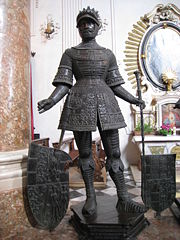

Albrecht Dürer
Albrecht Dürer was a German painter, printmaker, engraver, mathematician, and theorist from Nuremberg. His prints established his reputation across Europe when he was still in his twenties, and he has been conventionally regarded as the greatest artist of the Northern Renaissance ever since...
, Jörg Kölderer, Jörg Polhamer the elder, and Ulrich Tiefenbrunn, and sculptors Peter Vischer the Elder
Peter Vischer the Elder
Peter Vischer the Elder was a German sculptor, the son of Hermann Vischer, and the most famous member of the noted Vischer Family of Nuremberg....
, Hans Leinberger, Leonhart Magt, and Veit Stoß
Veit Stoss
Veit Stoss was a leading Bavarian sculptor, mostly in wood, whose career covered the transition between the late Gothic and the Northern Renaissance. His style emphasized pathos and emotion, helped by his virtuoso carving of billowing drapery; it has been called "late Gothic Baroque"...
. Three of the statues are based on designs by Dürer. The statues are as follows:
- 1 Queen Juana of Spain
- 2 King Ferdinand the Catholic of Spain
- 3 Duke Philip the Good of Burgundy
- 4 Duke Charles the Bold of Burgundy
- 5 Duchess Cymburgis of MasoviaCymburgis of MasoviaCymburgis of Masovia in January 1412 became the second wife of the Habsburg Duke Ernest the Iron of Austria and thus a Duchess/Archduchess of the Inner Austrian line in Styria, Carinthia and Carniola.Cimburgis was born at Warsaw in the Duchy of Masovia to Duke...
- 6 Archduchess Margarethe of Austria
- 7 Empress Maria Bianca Sforza
- 8 Sigismund, Archduke of AustriaSigismund, Archduke of AustriaSigismund of Austria, Duke, then Archduke of Further Austria was a Habsburg archduke of Austria and ruler of Tirol from 1446 to 1490....
(Sigismund with the Many Coins) - 9 King ArthurKing ArthurKing Arthur is a legendary British leader of the late 5th and early 6th centuries, who, according to Medieval histories and romances, led the defence of Britain against Saxon invaders in the early 6th century. The details of Arthur's story are mainly composed of folklore and literary invention, and...
- 10 King Ferdinand of Portugal
- 11 Ernest, Duke of AustriaErnest, Duke of AustriaErnest the Iron was Duke of Styria, Carinthia and Carniola from 1406 until his death. He was a member of the Habsburg dynasty, of the Leopoldian line, whose head of the family he was from 1411 to 1424.-Biography:...
- 12 Theoderic the Great
- 13 Duke Albrecht II the Wise of Austria
- 14 King Rudolf I
- 15 King Philip the Fair of Castile
- 16 ClovisClovis IClovis Leuthwig was the first King of the Franks to unite all the Frankish tribes under one ruler, changing the leadership from a group of royal chieftains, to rule by kings, ensuring that the kingship was held by his heirs. He was also the first Catholic King to rule over Gaul . He was the son...
the King of the Franks - 17 King Albrecht II
- 18 Emperor Frederick III
- 19 Saint Leopold III
- 20 Count Albrecht IV of Habsburg
- 21 Leopold III, Duke of AustriaLeopold III, Duke of AustriaDuke Leopold III of Austria from the Habsburg family, was Duke of Austria from 1365 to 1379, and Duke of Styria and Carinthia in 1365–1386.-Life:...
- 22 Frederick IV, Duke of AustriaFrederick IV, Duke of AustriaFrederick IV, Duke of Further Austria , also known as Frederick of the Empty Pockets, was the Habsburg duke of Further Austria from 1402, and Count of Tyrol from 1406, until his death...
(Frederick with the Empty Pockets) - 23 Albert I of GermanyAlbert I of GermanyAlbert I of Habsburg was King of the Romans and Duke of Austria, the eldest son of German King Rudolph I of Habsburg and his first wife Gertrude of Hohenburg.-Life:...
- 24 Godfrey of BouillonGodfrey of BouillonGodfrey of Bouillon was a medieval Frankish knight who was one of the leaders of the First Crusade from 1096 until his death. He was the Lord of Bouillon, from which he took his byname, from 1076 and the Duke of Lower Lorraine from 1087...
, King of Jerusalem - 25 Queen Elisabeth of Hungary
- 26 Queen Maria of Burgundy
- 27 Queen Elisabeth of TirolElisabeth of TirolElisabeth of Gorizia-Tyrol from the House of Meinhardin was Queen of the Romans, Queen of Germany and Duchess of Austria by marriage...
(Görz-Tyrol) - 28 Kunigunde of AustriaKunigunde of AustriaKunigunde of Austria was an Austrian Archduchess member of the House of Habsburg and by marriage Duchess of Bavaria-Munich and since 1503 over all Bavaria....
The gallery contains 23 small statues (66 - 69 cm) of the Habsburg patron saints. They were designed by court painter Jörg Köldere around 1514/15, and carved into wood and then wax by Leonhard Magt. The church also once contained a number of busts of Roman emperors; 20 are now displayed in Schloß Ambras and one is in the Bavarian National Museum
Bavarian National Museum
The Bavarian National Museum in Munich is one of the most important cultural history museums in Europe.-Building and History:...
in Munich
Munich
Munich The city's motto is "" . Before 2006, it was "Weltstadt mit Herz" . Its native name, , is derived from the Old High German Munichen, meaning "by the monks' place". The city's name derives from the monks of the Benedictine order who founded the city; hence the monk depicted on the city's coat...
.
Andreas Hofer tomb
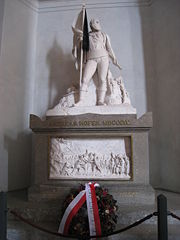
Andreas Hofer
Andreas Hofer was a Tirolean innkeeper and patriot. He was the leader of a rebellion against Napoleon's forces....
, Tirol
German Tyrol
German Tyrol is a historical region in the Alps now divided between Austria and Italy. It includes largely ethnic German areas of historical County of Tyrol: the Austrian state of Tyrol and the province of South Tyrol but not the largely Italian-speaking province of Trentino .-History:German...
's national hero, is also buried within the church. Sculptor Johann Nepomuk Schaller made his statue; Josef Klieber created the relief of the "Fahnenschwur" (Swearing on the flag) based on a sketch by Josef Martin Schärmer.

